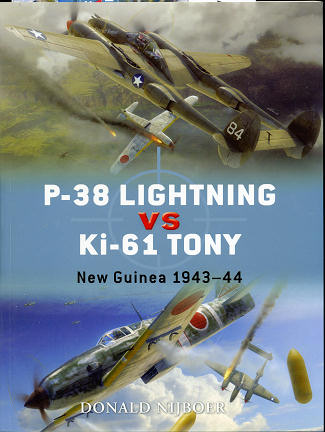 Osprey's
Duel series continues with this title pitting two of the Southwest Pacific's
adversaries against each other; the P-38 Lightning and the Ki-61 'Tony'. About
the only thing these planes have in common are liquid cooled engines and room
for one.
Osprey's
Duel series continues with this title pitting two of the Southwest Pacific's
adversaries against each other; the P-38 Lightning and the Ki-61 'Tony'. About
the only thing these planes have in common are liquid cooled engines and room
for one.
The P-38 was very much the aircraft of choice for many USAAF
pilots as it combined superb range, the safety of two engines, heavy firepower
and the ability to pretty much handle most of what was sent up against it. The
Ki-61, on the other hand was fast, had armor and self sealing fuel tanks to its
plus, but was undergunned and fraught with an unreliable engine, poor spare
parts availability and poorly trained mechanics. Such was the serviceability of
these planes that they could not have the engine changed in the field, but had
to be returned to what was basically depot level maintenance for that service.
It does make things seem rather one sided in favor of the
Lightning, but in the hands of an experienced pilot, the Tony was a deadly
adversary. Thankfully for the USAAF, there were not that many experienced pilots
and the serviceability of the Tony was so low that only a few weeks into combat,
the Japanese had difficulty fielding more than a handful of planes. In fact,
when the Allies finally overran the Japanese air bases on the northern coast of
New Guinea, they found dozens of aircraft that were only lacking some small
items to get them back into the air.
Couple this with a low production rate, and you can see that
the Japanese were not ready for a long and protracted war. Allied bombing of the
Ki-61's engine factory meant hundreds of engine-less airframes were sitting
outside the Kawasaki factory. This led to installing a radial engine and
creating the Ki-100, an aircraft that many think was the best Japanese piston
engine plane of the war. As usual, it was to few too late.
In this book, the author, Donald Nijboer, discusses the
development of both aircraft as well as their technical specifications and
deployments in the Southwest Pacific. Pilot training and tactics are also part of the story
and one will find a few 'I was there' stories to add some spice to the book. As
part of the appendices, there is a section on stats and analysis as well as a
listing of those aces on both sides whose scores included a number of the
opposing aircraft.
In all, a superlative inclusion to this series and one that I
know you will find useful.
May 2010
For more on the complete line of Osprey books,
visit www.ospreypublishing.com. In the US, it is
Osprey Direct at 44-02 23rd St, Suite 219, Long Island City, NY 11101., where you can
get a catalogue of available books.
If you would like your product reviewed fairly and quickly, please contact
me or see other details in the Note to
Contributors.
 Osprey's
Duel series continues with this title pitting two of the Southwest Pacific's
adversaries against each other; the P-38 Lightning and the Ki-61 'Tony'. About
the only thing these planes have in common are liquid cooled engines and room
for one.
Osprey's
Duel series continues with this title pitting two of the Southwest Pacific's
adversaries against each other; the P-38 Lightning and the Ki-61 'Tony'. About
the only thing these planes have in common are liquid cooled engines and room
for one.